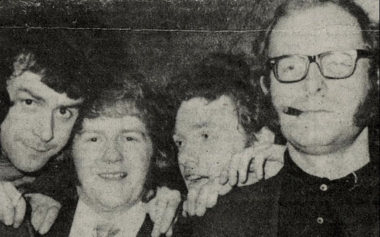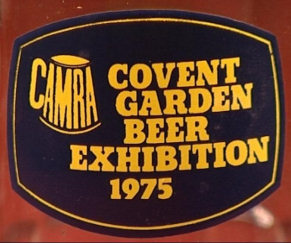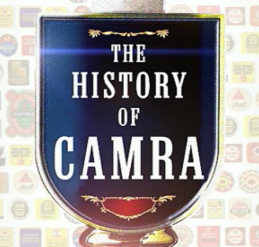| |
The History of CAMRA
by Willard Clarke, 08/2011
And now: CAMRA the Movie! You're probably aware that the Campaign for Real Ale is celebrating its 40th anniversary this year and to emphasise the point a film has been launched that traces the history of the movement and its success in saving cask beer.
In spite of a rather dull title - The History of CAMRA - it's a remarkable film in many ways. It traces not only a consumer revolt that has changed the appreciation of beer in Britain and saved a unique beer style but it's also a major documentary that shows how British society has altered since the early 1970s.
The film, directed by David Rust of Lagoon Media, is an independent production supported by but not controlled by CAMRA. It's packed with fascinating black-and white footage from the 70s that shows the way in
which the arrival of the Big Six national brewers transformed the way beer was made. Wooden casks and coopers were on their way out as family-run brewers folded at the knees. The future, we were told,
lay in filtered and pasteurised beer stored in pressurised kegs. We were all destined to drink Watneys Red and Double Diamond.
 Then along came four young beer lovers - all hairy sideburns and flared jeans - who decided to take on the big brewers and save beer with taste and flavour. Unlike another Fab Four, they're all still alive and
amazingly hale and hearty despite sinking a gallon or two in the intervening years. They're Michael Hardman, Jim Makin, Bill Mellor and Graham Lees and they explain in lengthy interviews how they found they had
tapped into a great well of discontent among thousands of fellow beer drinkers. Above, the founders circa 1970, left to right: Hardman, Mellor, Makin and Lees.
The message from the slick PR departments of the Big Six at the time was that a handful of grumblers were living in the past and most people were happy to drink keg beer. The founding four proved them wrong. People rushed to join the Campaign for the Revitalisation of Ale as it was first called, swiftly changed to Real Ale on the grounds that it was more manageable and easier to say after four pints of Old Jockstrap.
Hardman and co also found there were an astonishing number of people around with great expertise: they knew how beer was brewed, what happened to living ale inside a cask in a pub cellar, how to tap and peg it, and how to measure original gravity. It's hard to believe today, but in the 1970s brewers refused to declare the strength of their beers and guarded such information as though it were bars of gold in the vaults of the Bank of England.
One of the funniest moments in the film is the recounting of how CAMRA members would pour small samples of beer into bottles in pubs and then smuggled the samples to a friendly technician in the Guinness laboratory, who measured the strength. The early editions of the Good Beer Guide published the original gravities of cask ales and the brewers were forced to give in and declare the strengths of their brews.
Then along came four young beer lovers - all hairy sideburns and flared jeans - who decided to take on the big brewers and save beer with taste and flavour. Unlike another Fab Four, they're all still alive and
amazingly hale and hearty despite sinking a gallon or two in the intervening years. They're Michael Hardman, Jim Makin, Bill Mellor and Graham Lees and they explain in lengthy interviews how they found they had
tapped into a great well of discontent among thousands of fellow beer drinkers. Above, the founders circa 1970, left to right: Hardman, Mellor, Makin and Lees.
The message from the slick PR departments of the Big Six at the time was that a handful of grumblers were living in the past and most people were happy to drink keg beer. The founding four proved them wrong. People rushed to join the Campaign for the Revitalisation of Ale as it was first called, swiftly changed to Real Ale on the grounds that it was more manageable and easier to say after four pints of Old Jockstrap.
Hardman and co also found there were an astonishing number of people around with great expertise: they knew how beer was brewed, what happened to living ale inside a cask in a pub cellar, how to tap and peg it, and how to measure original gravity. It's hard to believe today, but in the 1970s brewers refused to declare the strength of their beers and guarded such information as though it were bars of gold in the vaults of the Bank of England.
One of the funniest moments in the film is the recounting of how CAMRA members would pour small samples of beer into bottles in pubs and then smuggled the samples to a friendly technician in the Guinness laboratory, who measured the strength. The early editions of the Good Beer Guide published the original gravities of cask ales and the brewers were forced to give in and declare the strengths of their brews.
 The depth of feeling about the disappearance of cask beer as a result of the waves of mergers and closures in the 70s was highlighted when CAMRA, tentatively, organised a beer festival in the Old Flower
Market in London's Covent Garden. Would anyone turn up, the organisers wondered? Would all that beer go to waste?
On the contrary, beer drinkers queued round the block and the festival was drunk dry. CAMRA members roared off in their Ford Anglias and Hillman Minx to get further supplies from bemused brewers who thought
they were facing oblivion rather than great consumer demand.
The film has clips from a late-1970s BBC documentary, The Philpott File, that covered the rise of CAMRA and juxtaposed it with such vast "mega-keggeries" as the Samlesbury brewery in Lancashire, an industrial sprawl of high-rise conical fermenters geared to producing vast amounts of keg ale and the Whitbread version of Heineken lager. This was beer brewed without conviction, increasingly controlled by computers, beer that needed neither skill nor passion.
When I joined CAMRA in 1976, it had 30,000 members. Today that number stands at 125,000 and it shows no sign of slowing. This year's Great British Beer Festival attracted an unprecedented clamour for tickets while the number of new small breweries starting up defies a stagnant economy and pub closures.
CAMRA is indisputably the world's most influential single-issue consumer movement. Cynics - and there's always no shortage of them - may point to the fact that the giant global brewers who have replaced the old Big Six brew around 80% of all the beer brewed in Britain.
But the likes of Carlsberg, Heineken and Molson Coors are starting to get the message that cask beer is the only sign of growth in a declining beer market and are taking a belated interest in the sector. Most importantly, the army of small brewers constitute a profound counter-culture, a defiance of the "logic" of the market that says only big brands can win.
The depth of feeling about the disappearance of cask beer as a result of the waves of mergers and closures in the 70s was highlighted when CAMRA, tentatively, organised a beer festival in the Old Flower
Market in London's Covent Garden. Would anyone turn up, the organisers wondered? Would all that beer go to waste?
On the contrary, beer drinkers queued round the block and the festival was drunk dry. CAMRA members roared off in their Ford Anglias and Hillman Minx to get further supplies from bemused brewers who thought
they were facing oblivion rather than great consumer demand.
The film has clips from a late-1970s BBC documentary, The Philpott File, that covered the rise of CAMRA and juxtaposed it with such vast "mega-keggeries" as the Samlesbury brewery in Lancashire, an industrial sprawl of high-rise conical fermenters geared to producing vast amounts of keg ale and the Whitbread version of Heineken lager. This was beer brewed without conviction, increasingly controlled by computers, beer that needed neither skill nor passion.
When I joined CAMRA in 1976, it had 30,000 members. Today that number stands at 125,000 and it shows no sign of slowing. This year's Great British Beer Festival attracted an unprecedented clamour for tickets while the number of new small breweries starting up defies a stagnant economy and pub closures.
CAMRA is indisputably the world's most influential single-issue consumer movement. Cynics - and there's always no shortage of them - may point to the fact that the giant global brewers who have replaced the old Big Six brew around 80% of all the beer brewed in Britain.
But the likes of Carlsberg, Heineken and Molson Coors are starting to get the message that cask beer is the only sign of growth in a declining beer market and are taking a belated interest in the sector. Most importantly, the army of small brewers constitute a profound counter-culture, a defiance of the "logic" of the market that says only big brands can win.
 CAMRA has made it possible for small brewers to flourish. Britain's great beer culture and heritage has been saved thanks to the campaign's energy and commitment. Do watch the film. It records how the little people stood up to the rich and powerful...and won.
The History of CAMRA
CAMRA has made it possible for small brewers to flourish. Britain's great beer culture and heritage has been saved thanks to the campaign's energy and commitment. Do watch the film. It records how the little people stood up to the rich and powerful...and won.
The History of CAMRA
Lagoon Media
One hour 45 minutes
£10.00, available from:
www.camra.org.uk
www.britishlocalhistories.com.
|
|

